动手学Transformer
Posted gongyanzh
tags:
篇首语:本文由小常识网(cha138.com)小编为大家整理,主要介绍了动手学Transformer相关的知识,希望对你有一定的参考价值。
动手实现Transformer,所有代码基于tensorflow2.0,配合illustrated-transformer更香。
- 模型架构
- Encoder+Decoder
- Encoder
- Decoder
- Attention
- Add&Norm
- FeedForward
- Embedding
- Position Encoding
- Encoder+Decoder
模型架构
transformer使用经典的编码器-解码器框架,编码器接受一个输入序列 ((x_1,…,x_n)),经过Embedding转化为词向量,和位置编码相加作为Encoder的输入,在一顿操作后输入被映射到(z=(z_1,…,z_n)),Decoder基于(z)在一顿操作后生成输出序列((y_1,…,y_m))。
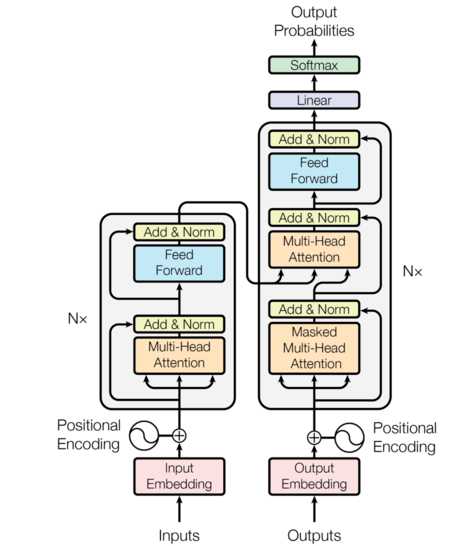
看图说话
- 左边是Encoder,输入为词ID序列,对应形状([batch size,max input sentense length]),如果embedding维度设置为512,输出形状为([batch size, max input sentence length, 512]),(Nx)表示将Encoder模块堆叠(N)次(论文中(N=6))
- 右边是Decoder,训练阶段,Decoder输入包括目标句子的词ID序列和最后一个Encoder部分的输出,测试阶段,Decoder的输入为上一次输出的词。Decoder同样被堆叠(N)次,最后一个Encoder的输出被接到每一个Decoder块的输入。Decoder输出下一个词的概率,输出形状为([batch size, max output sentence length, vocabulary length])) 。
我们先盖房子在装修
class Transformer(tf.keras.Model):
‘‘‘
Transformer架构,Encoder-Decoder;softmax
params:
num_layers:堆叠层数
dim_model:embedding 维度
num_heads:multihead attention
dim_ff:FeedForWard 维度
input_vocab_size:输入词典大小
target_vocab_size:输出词典大小
rate:dropout rate
‘‘‘
def __init__(self,num_layers, dim_model, num_heads, dim_ff, input_vocab_size,target_vocab_size, rate=0.1):
super(Transformer, self).__init__()
self.encoder = Encoder(num_layers, dim_model, num_heads,dim_ff, input_vocab_size, rate)#Encoder
self.decoder = Decoder(num_layers, dim_model, num_heads,dim_ff, target_vocab_size, rate)#Decoder
self.output_layer = tf.keras.layers.Dense(target_vocab_size)
def call(self, inputs, targets, training, enc_padding_mask, look_ahead_mask, dec_padding_mask):
encoder_output = self.encoder(inputs, training, enc_padding_mask) # (batch_size, inputs_seq_len, d_model)
decoder_output, attention_weights = self.decoder(targets, encoder_output, training, look_ahead_mask, dec_padding_mask)
output = self.output_layer(decoder_output) # (batch_size, tar_seq_len, target_vocab_size)
return output, attention_weights
- Encoder
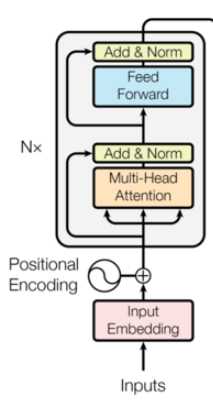
Encoder接受输入token的embedding和位置编码,经过N次Encoder layer 堆叠,代码如下所示
class Encoder(tf.keras.layers.Layer):
‘‘‘
Encoder 部分,input embedding ;Encoder layer stack
‘‘‘
def __init__(self, num_layers, dim_model, num_heads,dim_ff, input_vocab_size, rate=0.1):
super(Encoder, self).__init__()
self.dim_model = dim_model
self.num_layers = num_layers
self.embedding = tf.keras.layers.Embedding(input_vocab_size, self.dim_model)#输入Embedding
self.pos_encoding = positional_encoding(input_vocab_size, self.dim_model)#位置编码
self.enc_layers = [EncoderLayer(dim_model, num_heads, dim_ff, rate) for _ in range(num_layers)]#创建Encoder layer
self.dropout = tf.keras.layers.Dropout(rate)
def call(self, x, training, mask):
seq_len = tf.shape(x)[1]
# adding embedding and position encoding.
x = self.embedding(x) # (batch_size, input_seq_len, dim_model)
# x *= tf.math.sqrt(tf.cast(self.dim_model, tf.float32))
x += self.pos_encoding[:, :seq_len, :]
x = self.dropout(x, training=training)
for layer in self.enc_layers:
x = layer(x, training, mask)
return x # (batch_size, input_seq_len, d_model)
单个Encoder layer 有两个子层: attention层和point wise feed forward network.
class EncoderLayer(tf.keras.layers.Layer):
‘‘‘
Encoder layer:
multihead attention;add&layer norm;FeedForward;add&layer norm
‘‘‘
def __init__(self, dim_model, num_heads, dim_ff, rate=0.1):
super(EncoderLayer, self).__init__()
self.mha = MultiHeadAttention(dim_model, num_heads)
self.ffn = point_wise_feed_forward_network(dim_model, dim_ff)
self.layernorm1 = tf.keras.layers.LayerNormalization(epsilon=1e-6)
self.layernorm2 = tf.keras.layers.LayerNormalization(epsilon=1e-6)
self.dropout1 = tf.keras.layers.Dropout(rate)
self.dropout2 = tf.keras.layers.Dropout(rate)
def call(self, x, training, mask):
attn_output, _ = self.mha(x, x, x, mask) # (batch_size, input_seq_len, d_model)
attn_output = self.dropout1(attn_output, training=training)
out1 = self.layernorm1(x + attn_output) # (batch_size, input_seq_len, d_model)
ffn_output = self.ffn(out1) # (batch_size, input_seq_len, d_model)
ffn_output = self.dropout2(ffn_output, training=training)
out2 = self.layernorm2(out1 + ffn_output) # (batch_size, input_seq_len, d_model)
return out2
- Decoder
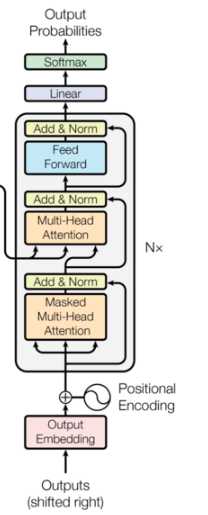
Decoder和Encoder类似,由N个Decoder layer 堆叠而成, 接受输入有三部分:token embedding、位置编码、 最后一个Encoder的输出
class Decoder(tf.keras.layers.Layer):
‘‘‘
Decoder 部分:
input embedding;Decoder layer stack;
‘‘‘
def __init__(self,num_layers,dim_model, num_heads, dim_ff, target_vocab_size, rate=0.1):
super(Decoder, self).__init__()
self.dim_model = dim_model
self.num_layers = num_layers
self.embedding = tf.keras.layers.Embedding(target_vocab_size, self.dim_model)
self.pos_encoding = positional_encoding(target_vocab_size, self.dim_model)
self.dec_layers = [DecoderLayer(dim_model, num_heads, dim_ff, rate) for _ in range(num_layers)]#创建Decoder layer
self.dropout = tf.keras.layers.Dropout(rate)
def call(self,x,enc_output,training,look_ahead_mask,padding_mask):
seq_len = tf.shape(x)[1]
attention_weights = {}
x = self.embedding(x)# (batch_size, target_seq_len, d_model)
x += self.pos_encoding[:,:seq_len,:]
for i,layer in enumerate(self.dec_layers):
x,block1,block2 = layer(x,enc_output,training,look_ahead_mask, padding_mask)
attention_weights[‘decoder_layer{}_block1‘.format(i+1)] = block1
attention_weights[‘decoder_layer{}_block2‘.format(i+1)] = block2
# x.shape == (batch_size, target_seq_len, d_model)
return x, attention_weights
单个Decoder层有三个子层:masked attention层、attention层和point wise feed forward network. masked attention层会掩盖掉序列中还没看到的位置,attention层以target token 为query,Encoder输出为 key和value
class DecoderLayer(tf.keras.layers.Layer):
‘‘‘
Decoder layer:
masked multihead attention;add&norm;multihead attention;add&norm;FeedForward;add&norm
‘‘‘
def __init__(self, dim_model, num_heads,dim_ff,rate=0.1):
super(DecoderLayer,self).__init__()
self.mask_mha = MultiHeadAttention(dim_model, num_heads)
self.mha = MultiHeadAttention(dim_model, num_heads)
self.ffn = point_wise_feed_forward_network(dim_model, dim_ff)
self.layernorm1 = tf.keras.layers.LayerNormalization(epsilon=1e-6)
self.layernorm2 = tf.keras.layers.LayerNormalization(epsilon=1e-6)
self.layernorm3 = tf.keras.layers.LayerNormalization(epsilon=1e-6)
self.dropout1 = tf.keras.layers.Dropout(rate)
self.dropout2 = tf.keras.layers.Dropout(rate)
self.dropout3 = tf.keras.layers.Dropout(rate)
def call(self,x,enc_output, training, look_ahead_mask, padding_mask):
#masked multi-head attention
mask_attn_output, attn_weights_block1 = self.mask_mha(x,x,x,look_ahead_mask)
mask_attn_output = self.dropout1(mask_attn_output,training)
out1 = self.layernorm1(x + mask_attn_output)
#multi-head attention
attn_output,attn_weights_block2 = self.mha(out1,enc_output,enc_output,padding_mask)
attn_ouput = self.dropout2(attn_output, training=training)
out2 = self.layernorm2(attn_output + out1) # (batch_size, target_seq_len, d_model)
# feed-forward
ffn_output = self.ffn(out2) # (batch_size, input_seq_len, d_model)
ffn_output = self.dropout2(ffn_output, training=training)
out3 = self.layernorm3(out1 + ffn_output) # (batch_size, input_seq_len, d_model)
return out3, attn_weights_block1, attn_weights_block2
- Attention
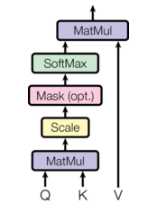
点积attention
def Attention(query,key,value,mask=None):
qk = tf.matmul(query,key,transpose_b=True)#对key进行转置
dk = tf.cast(tf.shape(key)[-1],tf.float32)
scale = qk / tf.math.sqrt(dk)
if mask is not None:
scale = scale + (mask*1e-9)#le-9接近于负无穷,对应softmax输出就为0
score = tf.nn.softmax(scale,axis=-1)
output = tf.matmul(score,value)
return output,score
- Multihead attention
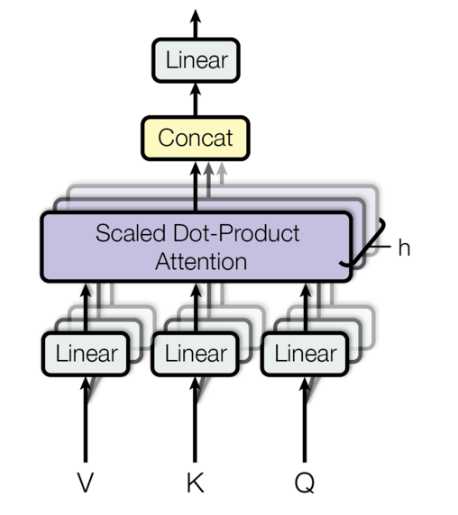
将输入划分为多个head,对应维度变化((batch\\_size,seq\\_len,dim\\_model) ightarrow (batch\\_size,head,seq\\_len,d_k)), 每个head操作不变,将多个head结果拼接经过权重矩阵(W^O)输出
class MultiHeadAttention(tf.keras.layers.Layer):
‘‘‘
Multihead attention
‘‘‘
def __init__(self,dim_model,num_heads):
super(MultiHeadAttention,self).__init__()
self.num_heads = num_heads
self.dim_model = dim_model
assert dim_model%self.num_heads == 0
self.d_k = dim_model//num_heads
self.wq = tf.keras.layers.Dense(dim_model)
self.wk = tf.keras.layers.Dense(dim_model)
self.wv = tf.keras.layers.Dense(dim_model)
self.wo = tf.keras.layers.Dense(dim_model)
def split_heads(self,x,batch_size):
#split 输入到多个head,(batch_size,seq_len,dim_model)->(batch_size,head,seq_len,self.d_k)
x = tf.reshape(x,(batch_size, -1, self.num_heads, self.d_k))
return tf.transpose(x,perm=[0,2,1,3])#重排输出维度
def call(self,q,k,v,mask):
batch_size = tf.shape(q)[0]
q = self.wq(q) # (batch_size, seq_len, dim_model)
k = self.wk(k)
v = self.wv(v)
q = self.split_heads(q, batch_size) # (batch_size, num_heads, seq_len_q, d_k)
k = self.split_heads(k, batch_size)
v = self.split_heads(v, batch_size)
attention,attention_weights = Attention(q,k,v,mask)
attention = tf.transpose(attention,perm=[0,2,1,3])
concat_attention = tf.reshape(attention,(batch_size,-1,self.dim_model))
return self.wo(concat_attention),attention_weights
- Masking
在解码时,为了保证预测当前词不会看到后面的词,需要将后面的词掩码掉。如下图所示,上三角元素为1,表示该位置需要被mask
#mask掉后面的词,保证预测前面词时看不到后面的
def look_ahead_mask(size):
"Mask out subsequent positions."
mask = tf.linalg.band_part(tf.ones((size, size)), 0, -1)#保留上三角,1表示需要被mask
return mask
plt.figure(figsize=(5,5))
plt.imshow(look_ahead_mask(20))
None
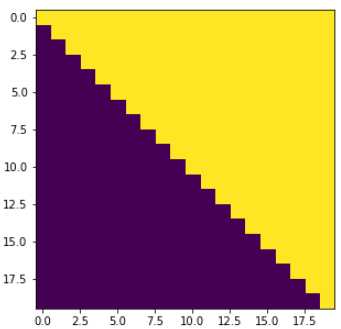
#序列填充mask,对padding位置输出1表示被填充
def padding_mask(seq):
seq = tf.cast(tf.math.equal(seq, 0), tf.float32)
# add extra dimensions so that we can add the padding
# to the attention logits.
return seq[:, tf.newaxis, tf.newaxis, :] # (batch_size, 1, 1, seq_len)
- Feed-Forward network
接在attention子层后面,用于增强非线性表示能力
def point_wise_feed_forward_network(dim_model, dim_ff):
model = tf.keras.Sequential()
model.add(tf.keras.layers.Dense(dim_ff, activation=‘relu‘))
model.add(tf.keras.layers.Dense(dim_model))
return model
- position encoding
位置编码是影响Transformer长文本建模的主要因素,由于input embedding 中不包含词的位置信息,需要加入位置编码表示词在句子中的位置信息。
为了表示词的绝对位置信息和相对位置信息,本文中使用了正余弦函数
其中 (pos) 表示位置,(i) 表示维度,关于为什么使用正余弦作为位置编码,可以参考这里。
def positional_encoding(maxlen,dim_model):
position = np.arange(0, maxlen)[:,np.newaxis]
div = np.array([1/np.power(10000.0,((2*i)/dim_model)) for i in range(dim_model)])[np.newaxis,:]
# div = np.exp(np.arange(0, dim_model, 2) * -(np.log(10000.0) / dim_model))
sine = np.sin(position*div[:,0::2])
cons = np.cos(position*div[:,1::2])
pos_encoding = np.concatenate([sine,cons], axis=-1)[np.newaxis, :]
return tf.cast(pos_encoding, dtype=tf.float32)
pos_encoding = positional_encoding(50, 512)
print (pos_encoding.shape)
plt.pcolormesh(pos_encoding[0], cmap=‘RdBu‘)
plt.xlabel(‘dim‘)
plt.xlim((0, 512))
plt.ylabel(‘Position‘)
plt.colorbar()
plt.show()
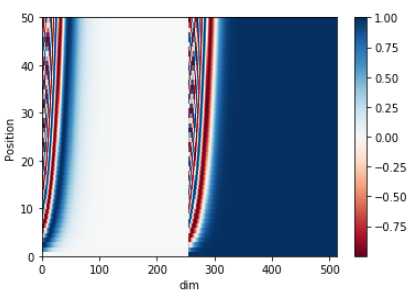
transformer的基本概念就先学到这里了
reference:
Illustrated-transformer. https://jalammar.github.io/illustrated-transformer/
Transformer_implementation_and_application. https://github.com/yuanxiaosc/Transformer_implementation_and_application
The Annotated Transformer. http://nlp.seas.harvard.edu/2018/04/03/attention.html#full-model
以上是关于动手学Transformer的主要内容,如果未能解决你的问题,请参考以下文章